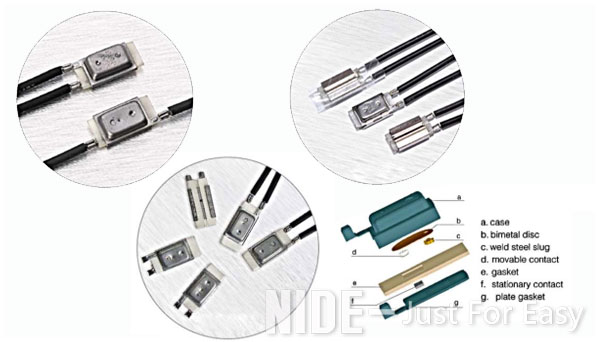2018-09-30
The thermal protector can be called a temperature control switch or a thermostat or a thermal protection switch or a temperature switch,
and is a thermal protector using a bimetal as a temperature sensing element.

1.the working principle of the thermal protector
The thermal protector is composed of two different alloys, which will generate heat after passing through the current.
When the electrical appliance is working normally, the bimetal is in a free state, and the contact is in a closed state.
When the temperature rises to the operating temperature value, Different alloys have different thermal expansion coefficients,
and the alloy tends to bend in one direction. The bimetal element is heated to generate internal stress and acts quickly.
When the contact leaves, the contact is opened to cut off the circuit, and the electric appliance is powered off, thereby providing thermal protection.
When the temperature drops to the set temperature, the contacts automatically close and return to normal operation.
2. thermal protector application
Thermal protectors are widely used in household appliances motors and electrical equipment, such as washing machine motors,
air conditioner fan motors, transformers, ballasts, electric heating appliances, fluorescent lamp thermal protectors, motor temperature switches,
motor temperature control switches, glue machine thermal switches , rechargeable battery temperature relay, solenoid temperature limiter,
household appliances snap-on thermostat, PCB board relay and so on.
3. thermal protector classification
According to the nature of the action: can be divided into normally open action, and normally closed action.
Divided by volume: can be divided into conventional large volume and ultra-thin, ultra-thin thermal protector battery pack dedicated,
ultra-thin thermal protector battery pack dedicated
4. matters needing attention
a. When the lead is bent, it should be bent from a part 6 mm or more from the root; when bending, the root and the lead should not be damaged,
and the lead should not be pulled, pressed or twisted.
b. When the thermal fuse is fixed by screws, riveting or terminal, it should be able to prevent mechanical creep and avoid contact failure.
c. The connecting parts should be able to work reliably within the working range of the electrical product without being displaced by vibration or shock.
d. When welding the lead wire, the heating humidity should be kept to a minimum. Be careful not to apply high temperature to the thermal fuse;
do not force, press or twist the thermal fuse and lead; after soldering, immediately cool for more than 30 seconds.
e. The thermal fuse can only be used under the specified rated voltage, current and specified temperature,
paying particular attention to the maximum continuous temperature of the thermal fuse.
Note: The nominal current, lead length and temperature can be designed according to customer requirements.
5. the use requirements
The thermal protector is structurally and functionally integrated with the motor to form a thermodynamic system that acts as a heater to affect the
heat generation and cooling rate of the protector. The reliability and performance of the thermal protector is such that the protector is mounted in the motor for testing.
When using a thermal protector, it must be determined whether the thermal protector is self-resetting or non-self-resetting.
In general, self-recovery can be used unless the motor is accidentally restarted, which may cause danger or damage to the user. heat protector.
Examples of applications that require the use of non-self-resetting protectors include fuel-operated motors, waste processors, conveyor belts, and more.
Examples of applications that require the use of self-resetting thermal protectors are refrigerators, electric washing machines, electric clothes dryers, fans, pumps, etc.